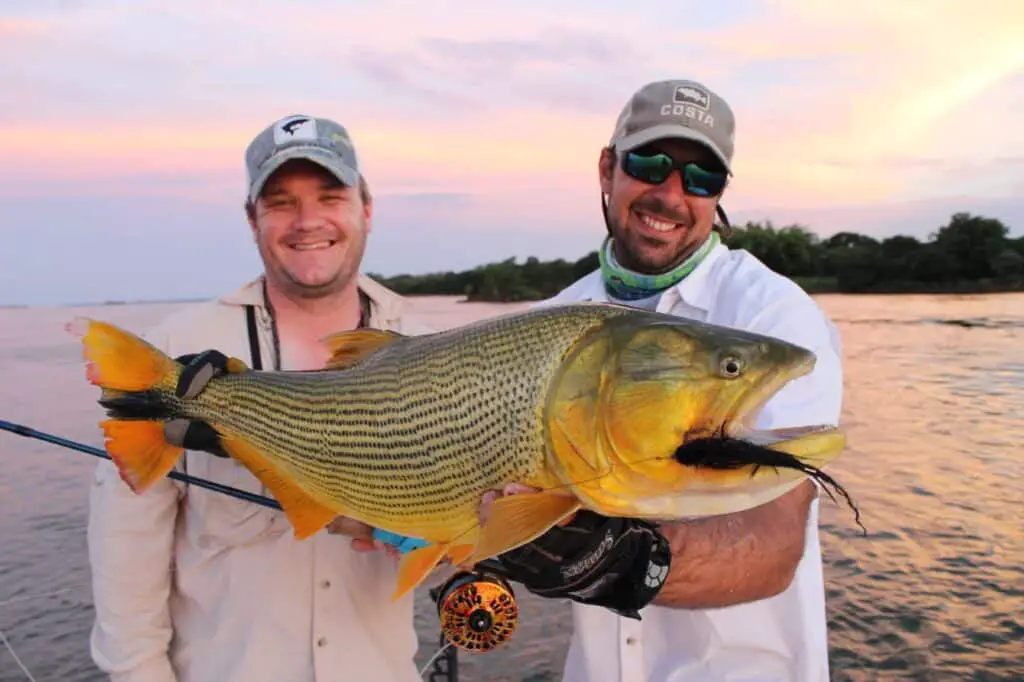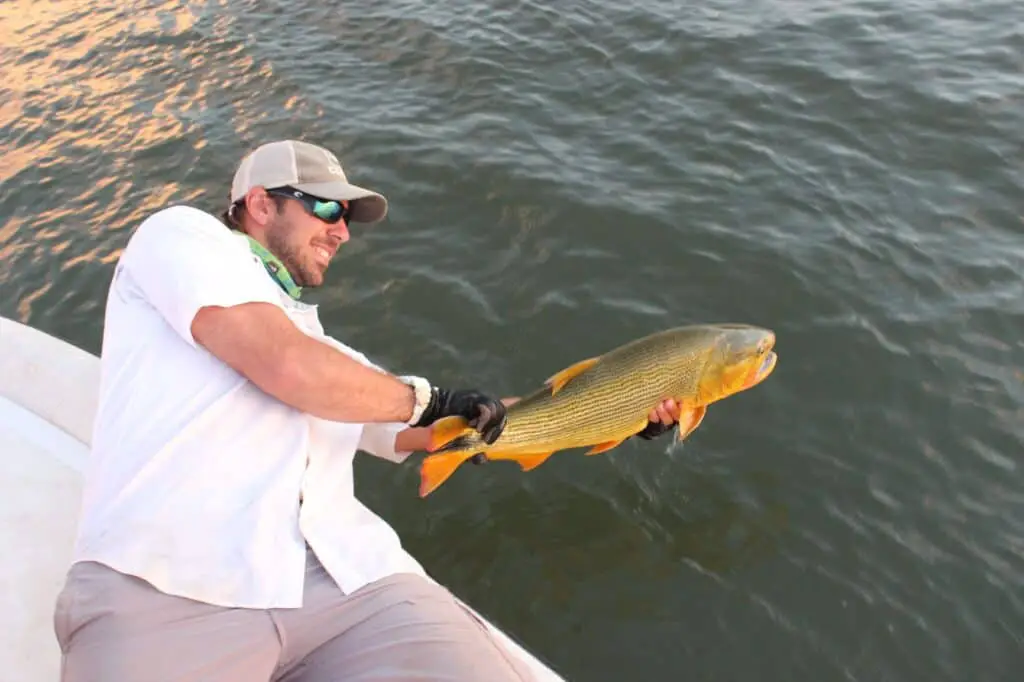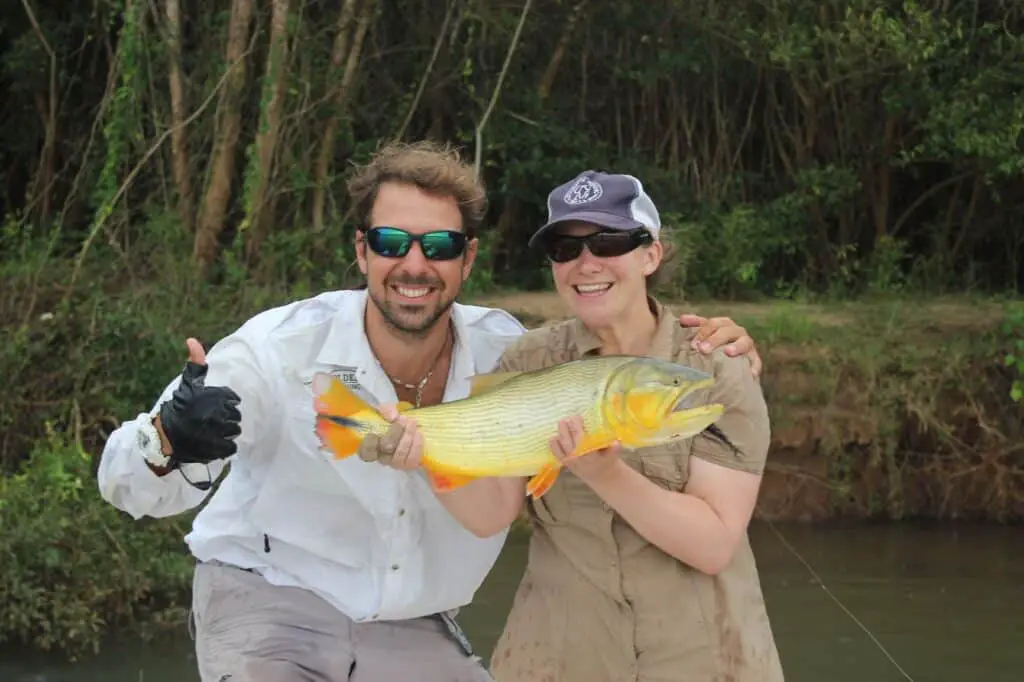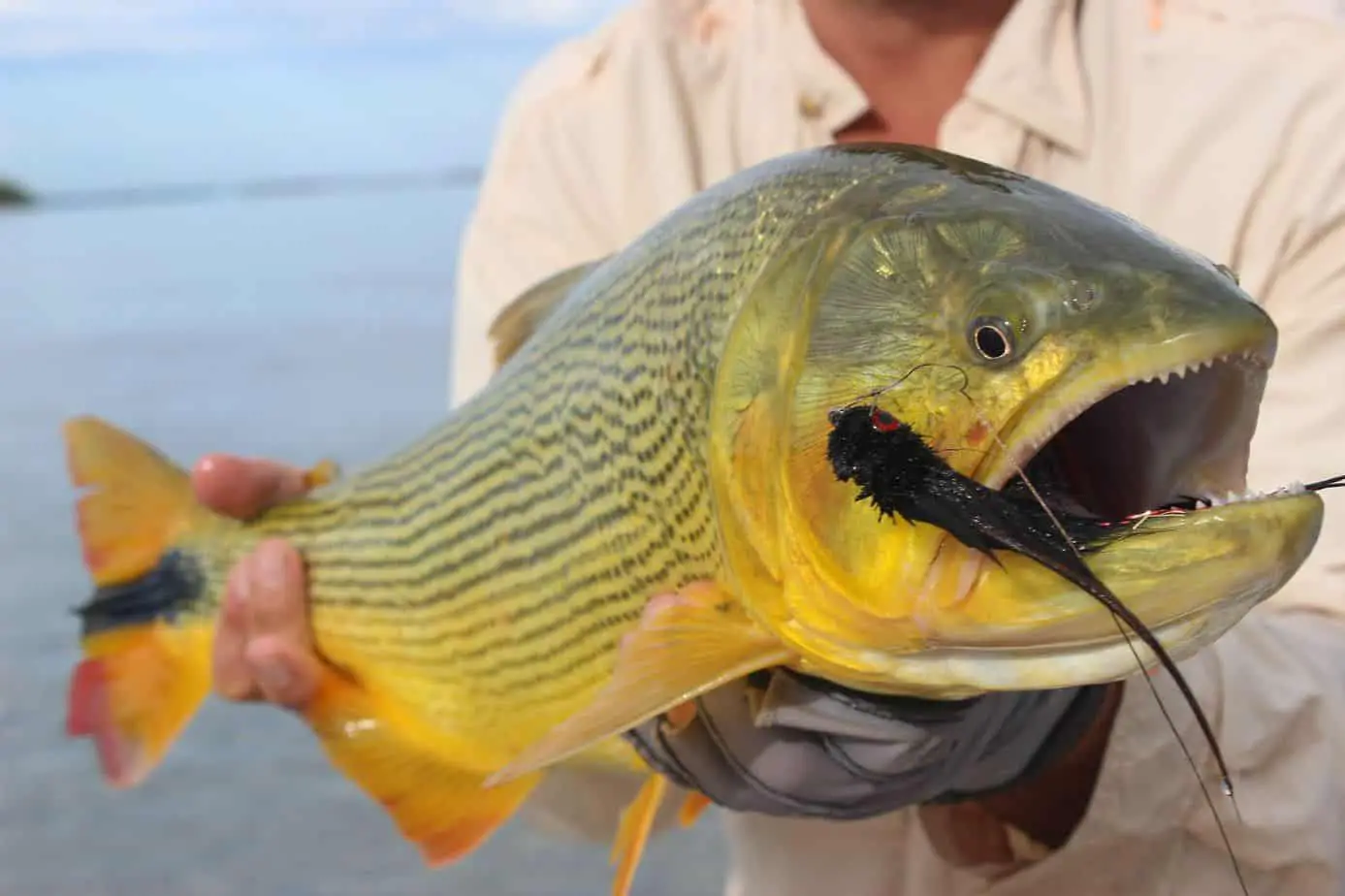Fly fishing for Golden Dorado is becoming increasingly popular. Golden Dorado are ferocious predators fished found in river systems throughout South America. Popular destinations to fish for these beautiful creatures are Argentina, Bolivia, and Brazil, amongst others.
Most countries throughout the continent have populations of Golden Dorado, many of which have been introduced to the ecosystem and are threatening to become an invasive species at the expense of native fish.
Fishing for Golden Dorado is unlikely to be like any form of fly fishing you have tried before. The techniques are different from the casting to the fly retrieval. Even setting the hook is a challenge due to the nature of its mouth. Golden Dorado teeth are scary!
If you plan to visit South America and fish for these beautiful creatures, it is best to acquaint yourself first with the techniques you will be using and the tackle you require.
In this article, we will go over the tackle requirements, cover some of the fishing available, and discuss the techniques required to catch this fantastic fish.
What Is A Golden Dorado?
The Golden Dorado, or to give it its scientific name – Salminus maxillosus or Salminus brasiliensis, is a river-dwelling fish that can grow to enormous sizes. This fish’s record is 75lbs, and the average size for a mature Golden Dorado is around 7 to 25lbs. Females tend to grow larger than males.
Despite its name, it is neither related to salmon or saltwater Dorado. It has a large head and a mouthful of razor-sharp teeth (care is required when handling these fish). It reaches maturity when it is around 15” long.
Upon reaching maturity is when the Golden Dorado takes on the gold color of its name. Immature fish tend to be more silvery colored.
These fish are on top of the food chain and can prey on anything up to about 4kg in weight. A 4kg catch would be a great day’s fishing, never mind catching something that eats 4kg prey!
Golden Dorado tend to inhabit warm water rivers throughout most of South America. For the most part, they are solitary fish, but they migrate upstream in shoals to the spawning grounds in the early spring and summer. Some of these migrations can be up to 250 miles.
This period can produce some of the best Golden Dorado fishing. If you plan to catch this migration, it is best to find the optimum time for the river you intend to fish.
Another great time to fish is during the baitfish migrations. The Golden Dorado will follow these migrations upstream to feed on them. The timings of this vary from river to river and depend on the species of baitfish as well.
It is an aggressive fish, and this explains its growing appeal to the angling community. Anglers now travel from all over the world to try and catch this spectacular fish.
When you hook a Golden Dorado, there is nothing else quite like it. Its stamina and power are legendary, and the sight of one of these creatures leaping out the water before screaming downstream with your fly in its mouth is like nothing you’ll have experienced before.

What Tackle Do I Need To Fish For Golden Dorado?
If you are lucky enough to be heading off on a trip to fish for Golden Dorado, then you need to consider what tackle to take along on your journey.
Rod
A bit of research about the location you are heading to would be recommended before you head off. Finding this information out beforehand is crucial when deciding what rod or rods to take.
On some waters, the fish may average only 10lbs or so. For these situations, a rod rated for a 7 or 8 weight rod. For waters where the fish can grow larger, a 9 or 10 weight or even up to an 11 weight is recommended.
One other thing to note, because Golden Dorado ten to hunt larger prey, you will be fishing with larger flies than you wouldn’t usually use. If you’re not used to fishing with larger flies, then consider going up a weight to give you more weight to turn that fly over smoothly.
Reel
A good drag is essential, these fish might not run exceptionally far, but they are powerful, and trying to hand line these chaps can be painful. Make sure you have a good controllable drag system and plenty of backing line.
Line
A floating line will be the primary line you use, but it is worth packing a sinking line or a sinking tip for when the river is high and murky.
However, regular freshwater lines are not great in the temperatures you are likely to be fishing in. They tend to get sticky and hard to work with. A fly line explicitly designed to work in saltwater/tropical climates is highly recommended.
Once again, the flies that you will be working with should be considered when choosing your line. Because of their build, it is best to get as aggressive a weight-forward taper as possible. This will help to turn that fly over.
Flies
Forget delicate dry flies or pretty little wet patterns. Here you need to think big, both with the pattern and the hook.
Golden Dorado are predators. You need to give them something they want to bite. Dark colors work best for this species. A collection of dark-colored streamers is going to be your leading choice.
Color combinations that work best are black paired with purple, orange, red, and green are usually highly successful.
The flies are best tied lightly weighted, sized anywhere between 3 to 6 inches, and tied on hook sizes from 2/0 to 3/0.
Also, streamers, large surface poppers, and dry flies can succeed in lower water conditions and clear water.
Leaders
Again, you need to think big here. Equip yourself with spools of 30 to 40lb monofilament or fluorocarbon. Nylon of this breaking strain is essential to help turn the fly over and for the strike’s savagery when you hook into one.
Because of the sharpness of the Golden Dorado’s teeth, you will also need to bring plenty of wire tippet material. A spool of 30lb stainless steel shock leader is essential if you don’t want to drop fish after fish along with your flies.
How To Fish For Golden Dorado?
If you haven’t fished for larger predators like Golden Dorado before, then be prepared to change a few of your methods to suit the fishing style required for success in catching this species.
Where To Find Golden Dorado?
Fishing for Golden Dorado uses very similar techniques as fishing for pike on a fly. The fish like to find features and lurk there, waiting to ambush their prey. Look for fallen logs, overhangs, undercut banks, or reed beds. The trick is to get your fly as close to these obstacles as possible.
When you find your spot and land your fly, don’t wait for it to sink, start to retrieve immediately as Golden Dorado will often lunge for your fly the moment it strikes the water.
Also, look for surface activity. Prey fish tend to be shoaling species. If you see a lot of activity, there is a good chance a Golden Dorado is doing a spot of feeding.

How Do I Strip The Line?
As mentioned earlier, begin to strip as soon as the fly hits the water. Experimentation is the name of the game. You can have great success on slow strips with small pulls and on different days have had equal success with fast retrieves and long pulls.
If you have a fish following, try and tempt it to strike by speeding up your retrieve, this can trigger that aggressive instinct and dispel any doubts that the fish may have had. Remember to play to their aggressive instincts.
If you’re working the margins of a reed bed or another feature, then strip the fly immediately, but after five or 6 pulls, if nothing has happened, retrieve and try again. It’s in the margins and around obstacles that the bulk of your fishing is successful.
For surface poppers, the technique is slightly different. Once you have cast the popper out, pause for a few seconds, then pause again between each tug.
Constant popping does not seem to work with Golden Dorado. Only if you see a fish following should you speed up your retrieve.
If the river is high and murky, you may want to use a sinking tip line and get your fly down deeper. When the river is like this, I have had great success with a figure of eight retrieve in these situations.
As with all fishing, it is a matter of seeing what works on any given day. These are general guidelines, not rules. If they’re not working, ignore them and do the exact opposite. Such is fishing.
Setting The Hook
If you are used to trout or salmon fishing, you will have to adjust your striking technique. But before you get that far, you must get your hooks as sharp as possible. Golden Dorado have hard, bony mouths, and it can be challenging to set the hook.
Keeping the rod low, you need to strike hard but viciously, steadily, and don’t ease off until the hook has had time to set itself properly. There is a good chance that the fish is going to jump. You need to keep that steady pressure on it for as long as possible. Often it is at this first jump the hook can get unset.
Hooking a Golden Dorado and making it stick is a skillset all on its own, so expect to lose a good percentage of the fish you hook into. But that’s fishing, after all.
Where To Fish For Golden Dorado?
This section of the article will discuss some of the prime locations for catching Golden Dorado. They vary in character and features, but one thing is consistent across all the locations, and that is the sheer beauty of the surroundings you will be fishing in.
Although there is plenty of fishing for Golden Dorado throughout the continent of South America. The prime countries that offer the best trips specifically geared towards Golden Dorado are Argentina and Bolivia. In both these countries, fishing options are limitless, and fishing is something you will never forget.
Argentina
Argentina is one of the prime countries if you are looking for some excellent Golden Dorado angling. Argentina has many rivers and deltas to choose from.
Parana River
Just to the north of, and within easy distance of Buenos Aires, the Parana River is a fantastic Golden Dorado fishery and stunningly beautiful. Close to Rio de Plata, this river’s delta begins, and the fishing can be phenomenal.
This vast area of the river contains hundreds of islands and smaller rivers, wetlands, and lagoons.
Uruguay River
Forming the border of Uruguay and Argentina, this vast and slow-moving river is perfect Golden Dorado country. It has endless water features for Golden Dorado to lie, waiting to ambush their unsuspecting prey and hopefully your fly.
Although it eventually forms part of the same delta as the Parana River, the fishing on the river itself is of a different character from the Delta fishing. Here you will be targeting those overhangs and submerged logs and obstacles.
Organizing A Trip To Argentina
Argentina has much more to offer in the way of Golden Dorado fishing. Many rivers throughout the whole country boast large populations of the species. These are just two of the more popular ones.
As with all Golden Dorado fishing, if you go to the lengths of planning a trip down to South American, you would be strongly advised to hire a guide or book a whole fishing experience.
Golden Dorado Fly Fishing Argentina are experts at arranging whole trips or even just a single day fishing. Their expert guides know these waters well and can lead you straight to the fish more often than not.
If you’re not sure about a fly fishing guide, read this, “Should I Hire A Fly Fishing Guide?”

Bolivia
Bolivia is considered a mecca for Golden Dorado fishing. It has some of the best fishing for the species, and anglers flock to it every year to try their hand at the spectacular fishing the country has to offer.
Secure River
On this river, most of Golden Dorado fishing takes place within the confines of a National Park. The territory is stunningly beautiful and remote, and access is almost impossible without it being part of an organized trip.
The river is part of the tributary system that ultimately feeds the Amazon, and it has some of the finest Golden Dorado fishing to be found anywhere in South America. For most of the river, catch and release is mandatory.
Pluma River
Arguably, the Pluma River region is the best Golden Dorado fishing to be found anywhere in the world. Located in the area where the Upper Amazon meets the Andes, this is an entire system of rivers and tributaries with an annual migration of hundreds of thousands of baitfish.
And of course, where there is baitfish, there is Golden Dorado. They follow the baitfish migrations, and if you time your trip right, you are in for an angling experience, never to be forgotten.
Organizing A Trip To Bolivia
Unless you are acquainted with Bolivia’s waterways and have an explorer’s mindset, the only way to truly experience the Bolivia Golden Dorado experience is by booking an organized trip. Many have lodges right on the prime fishing spots and can cater to all comers, including beginners.
A long-established company specializing in fishing trips worldwide, including Golden Dorado fishing in Bolivia, is Sport Quest Holidays, which have a range of trips available specifically to fish for this beautiful species.
Conclusion
The Golden Dorado fishery has become increasingly popular in recent years. There is something primeval about this stunning fish that makes catching it a thing of wonder.
It isn’t easy to fish for them, not from the point of view of the fishing but from the point of view of getting to where the fish are. For this reason, booking a guided trip is highly advised if you want to make the most of your fishing trip.
Argentina offers the best opportunities for those who don’t want to book a trip as some of the best fishing is located within easy driving distance of Buenos Aires.
One thing is for sure though, if you do make the trip, wherever you end up will be a place of natural wonder that few areas on the planet could match.
If you find this article helpful, don’t leave without sighing up for our newsletter and checking out our Recommended Fly Fishing Gear List.
Other Popular Fly Fishing Destination
*Featured Image: “Golden Dorado – check out the teeth” by Pia Andrews. Used Under CC BY4.0

